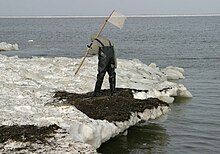Baltic amber



The Baltic region is home to the largest known deposit of amber, called Baltic amber or succinite. It dates from 44 million years ago (Eocene).[1] It has been estimated that these forests created over 105 tons of amber.[2]
The term Baltic amber is generic, so amber from the Bitterfeld brown coal mines in Saxony (Eastern Germany) goes under the same name. Bitterfeld amber was previously believed to be only 20–22 million years old (Miocene), but a comparison of the animal inclusions revealed that it is most probably genuine Baltic amber that has only been redeposited in a Miocene deposit.[3] Other sources of Baltic Amber have been listed as coming from Poland and Russia.
Because Baltic amber contains about 8% succinic acid, it is also termed succinite.
It was thought since the 1850s that the resin that became amber was produced by the tree Pinites succinifer, but research in the 1980s came to the conclusion that the resin originates from several species. More recently it has been proposed, on the evidence of Fourier-transform infrared microspectroscopy (FTIR) analysis of amber and resin from living trees, that conifers of the family Sciadopityaceae were responsible.[2] The only extant representative of this family is the Japanese umbrella pine, Sciadopitys verticillata.
Numerous extinct genera and species of plants and animals have been discovered and scientifically described from inclusions in Baltic amber.[4] Baltic amber includes the most species-rich fossil insect fauna discovered to date.
Paleobiology
Numerous organisms have been described from amber specimens including:

Fauna
- Agroecomyrmex Wheeler, 1910[5]
- Anonychomyrma constricta (Mayr, 1868)[6]
- Anonychomyrma geinitzi (Mayr, 1868)[6]
- Anonychomyrma samlandica (Wheeler, 1915)[6]
- Aspidopleura Gibson, 2009[7]
- Baltimartyria Skalski, 1995
- Brevivulva Gibson, 2009[7]
- Electrinocellia (Carpenter) Engel, 1995[8]
- Epiborkhausenites Skalski, 1973[9]
- Gracillariites Kozlov, 1987
- Electrocrania Kuznezov, 1941
- Fibla carpenteri Engel, 1995[8]
- Metapelma archetypon Gibson, 2009[7]
- Micropterix gertraudae Kurz & Kurz, 2010
- Neanaperiallus Gibson, 2009[7]
- Palaeovespa baltica Cockerell, 1909[10]
- Palaeovespa socialis Pionar, 2005[11]
- Prolyonetia Kusnetzov, 1941
- Propupa Stworzewicz & Pokryszko, 2006[12]
- Stigmellites baltica (Kozlov, 1988) (Lepidopteran leaf mines)
- Succinipatopsis Poinar, 2000[13]
See also
References
- ^ Ritzkowski, S. 1997. K-Ar-Altersbestimmungen der bernsteinführenden Sedimente des Samlandes (Paläogen, Bezirk Kaliningrad). Metalla, Bochum, 66: 19–23.
- ^ a b Wolfe, A.P.; et al. (2009). "A new proposal concerning the botanical origin of Baltic amber". Proceedings of the Royal Society B. 276 (1672): 3403–3412. doi:10.1098/rspb.2009.0806. PMC 2817186. PMID 19570786.
{{cite journal}}: Explicit use of et al. in:|author2=(help) - ^ Dunlop, J.A.; Giribet, G. (2003). "The first fossil cyphophthalmid (Arachnida: Opiliones), from Bitterfeld amber, Germany". Journal of Arachnology. 31: 371–378. doi:10.1636/h03-03.
- ^ Weitschat, W. & Wichard, W. 2002. Atlas of Plants and Animals in Baltic Amber. Pfeil, 256 pp.
- ^ Wheeler, W. M. (1915). "The ants of the Baltic amber". Schriften der Physikalisch-Okonomischen Gesellschaft zu Konigsberg. 55 (4): 56–59.
- ^ a b c Heterick, B. E.; Shattuck, S. (2011). "Revision of the ant genus Iridomyrmex (Hymenoptera: Formicidae)". Zootaxa. 2845: 169.
- ^ a b c d Gibson, G. A. P. (2009). "Description of three new genera and four new species of Neanastatinae (Hymenoptera, Eupelmidae) from Baltic amber, with discussion of their relationships to extant taxa". ZooKeys. 20. doi:10.3897/zookeys.20.161.
{{cite journal}}: CS1 maint: unflagged free DOI (link) - ^ a b Engel, M.S. (1995). "A new fossil snake-fly species from Baltic amber (Raphidioptera: Inocelliidae)". Psyche. 102 (3–4): 187–193. doi:10.1155/1995/23626.
{{cite journal}}: CS1 maint: unflagged free DOI (link) - ^ Skalski, A.W. (1973). "Studies on the Lepidoptera from fossil resins. Part II. Epiborkhausenites obscurotrimaculatus gen. et sp. nov. (Oecophoridae) and a tineid-moth discovered in the Baltic amber" (PDF). Acta Palaeontologica Polonica. 18 (1): 153–160.
- ^ Cockerell, T.D.A. (1906). "Fossil Hymenoptera from Florissant, Colorado" (PDF). Bulletin of the Museum of Comparative Zoology. L (2).
- ^ Poinar, G. (2005). "Fossil Trigonalidae and Vespidae (Hymenoptera) in Baltic amber". Proceedings of the Entomological Society of Washington. 107 (1): 55–63.
- ^ Stworzewicz E., Pokryszko B. M. (2006). "Eocene terrestrial snails (Gastropoda) from Baltic amber". Annales Zoologici 56(1): 215-224. abstract, abstract
- ^ Attention: This template ({{cite doi}}) is deprecated. To cite the publication identified by doi:10.1111/j.1744-7410.2000.tb00178.x, please use {{cite journal}} (if it was published in a bona fide academic journal, otherwise {{cite report}} with
|doi=10.1111/j.1744-7410.2000.tb00178.xinstead.
